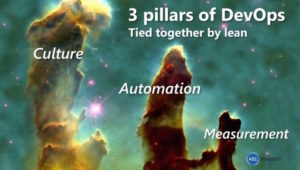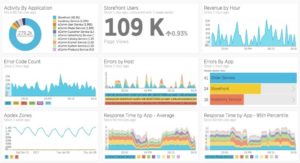Note: This post has been updated with links to additional resources. It was initially published in October, 2018.
Every IT professional has heard of DevOps by now. And most have heard enough to understand that DevOps , at its core, gives teams the tools, workplace culture, and organizational methods to accelerate the software development lifecycle.
All of this is true, of course, but it also barely scratches the surface of a very deep, and very important, topic. DevOps is transforming how we build software—and in the process, it is transforming how development and operations teams work, think, and collaborate. And if you’re looking for a high-growth, high-value IT career path, DevOps can deliver that, as well.
For many IT pros, however, the first step on a DevOps journey involves a basic grasp of its purpose and principles. That’s why we created this “crash course” in key DevOps-related topics, using resources gathered from New Relic and around the web
DevOps basics
We’ll start with suggestions for readers who need a true ground-floor orientation in what DevOps means and how it creates value. Here are our suggestions—with an emphasis on resources that set you up for success when you’re ready to drill down into more detailed discussions:
What Is DevOps? This New Relic online guide offers a quick but complete review of where DevOps came from, the problems its creators wanted to solve, and the anatomy of a modern DevOps organization. Think of this as the first step on your personal DevOps journey: a prerequisite that prepares you to jump into more detailed resources.
 DevOps 101: Moving Fast with Confidence. This 44-minute webinar video is your chance to watch New Relic Senior Product Marketing Manager Ravi Tharisayi quiz Donnie Berkholz, who was at the time research director for 451 Research, on DevOps best practices. Their conversation touches on some vivid examples that highlight the business value of DevOps. They also discuss the “three pillars” of a successful DevOps venture: culture, automation, and measurement—a structure mirrored in this post.
DevOps 101: Moving Fast with Confidence. This 44-minute webinar video is your chance to watch New Relic Senior Product Marketing Manager Ravi Tharisayi quiz Donnie Berkholz, who was at the time research director for 451 Research, on DevOps best practices. Their conversation touches on some vivid examples that highlight the business value of DevOps. They also discuss the “three pillars” of a successful DevOps venture: culture, automation, and measurement—a structure mirrored in this post.
Continuous Delivery, Continuous Deployment, and Continuous Integration: What’s the Difference? These terms refer to DevOps workflows that are central to creating a successful DevOps practice. They also provide a useful way to measure DevOps maturity, with organizations adopting one or more of these workflows as they step up their automation, measurement, tooling, and other capabilities. This post unpacks these terms and explores their origins, how they differ, and how they help software teams deliver better applications faster.
Bonus resource: The Incredible True Story of How DevOps Got Its Name
DevOps culture
The very term DevOps—a portmanteau of development and operations—speaks to its goal of tearing down the walls separating two groups that (hopefully) share a common goal. By most accounts, that’s more about changing an organization’s culture, collaboration practices, and attitudes than it is about adopting new tools and technology.
DevOps Culture. Software developer Rouan Wilsenach’s short but impactful guest post on Martin Fowler’s highly regarded blog offers a pointed, practitioner’s take on what DevOp culture really means, why it’s essential, and why the other pillars of DevOps depend upon a healthy DevOps culture—even as they help to support and sustain that culture.
Kickstarting DevOps. Subtitled “How to get everyone on board and successfully make the transition,” this New Relic ebook puts a special emphasis on DevOps’ prerequisites. Learn how to prepare your teams and gather the information you’ll need to maintain momentum and avoid unwelcome surprises on the path to DevOps nirvana.
DevOps automation and tools
Automating software development and deployment tasks and workflows is a key pillar of DevOps success. DevOps is all about replacing the inefficiencies and errors associated with manual process, allowing developers and IT folks to focus on innovation and creating value for the organization, instead of getting bogged down in routine maintenance.
Automation and the DevOps Workflow. This white paper, produced by software vendor Chef, is a dense but useful introduction to how and why automation is critical to successful DevOps. (The second half focuses on the Chef platform—which, along with other tools like Puppet and Ansible, figures prominently in many organizations’ DevOps plans.)
4 Simple Steps to Prioritizing Your DevOps Automation. As promised in the title, this useful post from TechBeacon lays out four steps for organizations just getting started planning their DevOps automation process. It’s pretty straightforward: 1) Evaluate your needs, 2) Identify your bottlenecks, 3) Consider the ROI, and 4) Continuously assess and reevaluate. The end result: “continuous monitoring and improving.”
DevOps measurement
Measurement is far more than just another item to check off your DevOps list, it's a critical pillar of any successful DevOps journey. It’s hard to imagine succeeding with DevOps without a firm grasp of how and why to monitor the performance, productivity, and outcomes of your software development projects.
DevOps Without Measurement Is a Fail. The title of this New Relic ebook, updated in 2018, promises to explain “How to measure and track the 5 critical drivers of DevOps success.” You’ll learn how to link DevOps to business success and a great customer experience, how to track application and infrastructure performance, how to increase engineering velocity, and what it takes to deliver quality software.
Guide to Measuring DevOps Success. This comprehensive set of tutorials provide best practices for using New Relic from the beginning to the end of your DevOps journey. The tutorials cover all three stages of measuring DevOps success: 1) Preparing your DevOps team, 2) Activating well-defined processes, and 3) Optimizing your team, process, and enterprise. Each guide focuses on identifying key performance metrics and delivering the best possible digital experience for your customers.
Dashboards for DevOps: Examples of What to Measure. Jonathan Owens, a Senior Site Reliability Engineer at New Relic, proves that a dashboard is worth a thousand words—especially when it comes to instrumenting and tracking your DevOps team and processes. Of particular interest: Jonathan’s in-depth look at building business-performance dashboards using hard numbers and hard-cash impact to assess the progress your DevOps efforts.
Modern Software Podcast: Gene Kim on Measuring DevOps Success. In this 2017 podcast, DevOps visionary Gene Kim dives into a number of measurement-related topics that both DevOps novices and experts will find illuminating. But there’s much more to this conversation between Gene and the New Relic Modern Software Podcast crew—ranging from what kinds of companies are using DevOps today and how they benefit from it, to busting common DevOps myths. Gene even offers a fresh take on the long-running conflict between speed and stability as software development imperatives.
DevOps security
Security is just as important to DevOps as it is to any other approach to software development. Fortunately, the same DevOps processes that enable companies to deliver better software faster also support a rigorous, yet efficient and flexible, approach to application security. 
SecDevOps: Injecting Security into DevOps Processes. In this blog post, New Relic technical content editor Isaac Eldridge explores “SecDevOps”—a set of best practices designed to “implant security deep in the heart of their DevOps development and deployment processes.” If DevOps is designed to minimize coding faults by automating development to reduce the opportunity for human error—and more quickly fix any errors that do occur—SecDevOps does the same thing for security vulnerabilities.
The New Relic DevOps story
Every organization has to start its DevOps journey somewhere, and New Relic is no exception. We’ve shared our own DevOps experiences in hopes of helping other modern software organizations find DevOps success as quickly as possible:
DevOps Done Right: Best Practices to Knock Down Barriers to Success. Here’s the perfect coda to a crash course in DevOps: A guide to ensure that your organization will finish what it started and avoid the pitfalls that can cause a DevOps transformation to stall out or accept mediocre results. We highlight lessons learned during New Relic’s own DevOps journey—with the goal of “bringing together proven best practices that show you how to move faster and more effectively than ever before.”
DevOps Career Planning
If you’re reading this post, chances are good that you’re at least curious about DevOps as a career option. Let’s start with the good news: According to a recent Enterprisers Project roundup of DevOps salary statistics and trends, the average salary for a DevOps Engineer position is roughly 30% higher than the average salary for all IT industry positions. While those figures mask variations due to regional differences, demand for specific skillsets and industry experience, and other factors, this is clearly a great time to begin a career with a DevOps specific focus.
Earning a degree or certification (or updating one, for IT professionals entering DevOps from another area of practice), or simply gaining sufficient on-the-job training, is a necessary first step towards landing your first DevOps job. But knowing what to expect during and after the hiring process can give you a critical edge against other applicants, especially for jobs at top-tier companies.
Our Guide to Critical DevOps Interview Questions—and How to Answer Them offers interview insights from a pair of veteran New Relic DevOps hiring managers. They’ll explain why they ask certain types of questions, and offer advice about how to craft high-quality answers. They also offer tips about the kinds of questions you should be asking the interviewer, both to demonstrate your knowledge as well as to assess whether a job is really a good fit with your own needs and preferences.
Another blog post—10 Secrets for Your Next DevOps Job Interview—serves up a series of facts that every DevOps practitioner should (but often doesn’t) know. While name-dropping The Phoenix Project or taking a position on the controversial “DevOps Engineer” job role may not seem like essential job interview fodder, these are exactly the types of little things that make a lasting impression—and a positive one—on a hiring manager.
Finally, it never hurts to look a step or two ahead on a career journey, especially if climbing the ranks into management is part of your plan. How to Manage a DevOps Team features a Q&A with one of New Relic’s own DevOps team leaders—running the gamut from inspiring teamwork and collaboration to preventing burnout.
As opiniões expressas neste blog são de responsabilidade do autor e não refletem necessariamente as opiniões da New Relic. Todas as soluções oferecidas pelo autor são específicas do ambiente e não fazem parte das soluções comerciais ou do suporte oferecido pela New Relic. Junte-se a nós exclusivamente no Explorers Hub ( discuss.newrelic.com ) para perguntas e suporte relacionados a esta postagem do blog. Este blog pode conter links para conteúdo de sites de terceiros. Ao fornecer esses links, a New Relic não adota, garante, aprova ou endossa as informações, visualizações ou produtos disponíveis em tais sites.




